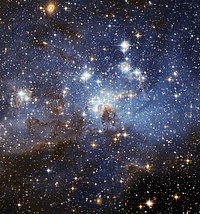
Photo from wikipedia
We study the formation and early evolution of star clusters that have a wide range of masses and background cloud mass surface densities, Σcloud, which help set the initial sizes,… Click to show full abstract
We study the formation and early evolution of star clusters that have a wide range of masses and background cloud mass surface densities, Σcloud, which help set the initial sizes, densities, and velocity dispersions of the natal gas clumps. Initial clump masses of 300, 3,000 and 30,000 M⊙ are considered, from which star clusters are born with an assumed 50% overall star formation efficiency and with 50% primordial binarity. This formation is gradual, i.e., with a range of star formation efficiencies per free-fall time from 1% to 100%, so that the formation time can range from 0.7 Myr for low-mass, high-Σcloud clumps to ∼30 Myr for high-mass, low-Σcloud clumps. Within this framework of the Turbulent Clump model, for a given Σcloud, clumps of higher mass are of lower initial volume density, but their dynamical evolution leads to higher bound fractions and causes them to form much higher density cluster cores and maintain these densities for longer periods. This results in systematic differences in the evolution of binary properties, degrees of mass segregation and rates of creation of dynamically ejected runaways. We discuss the implications of these results for observed star clusters and stellar populations.
Journal Title: Monthly Notices of the Royal Astronomical Society
Year Published: 2023
Link to full text (if available)
Share on Social Media: Sign Up to like & get
recommendations!